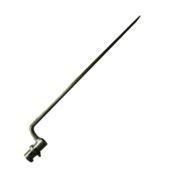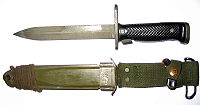History 
Early-19th century socket bayonet
The evolution of the bayonet can be traced to a certain extent to a fortuitous accident. In the mid-17th century irregular military conflicts of rural France, the peasants of the Southern French town of Bayonne, who were Basques, having run out of powder and shot, rammed their long-bladed hunting knives into the muzzles of their primitive muskets to fashion impromptu spears and, by necessity, created an ancillary weapon that was to influence Western European infantry tactics until the early 20th century. The weapon was introduced into the French army by General Jean Martinet.
The benefit of such a dual-purpose arm contained in one was soon apparent. The early muskets fired at a slow rate (about a round per minute when loading with loose powder and ball, and no more than 3–4 rounds per minute using paper cartridges), and were both inaccurate and unreliable. Bayonets provided a useful addition to the weapons system when an enemy charging to contact could cross the musket's killing ground (a range of approximately 100 yards/metres at the most optimistic) at the expense of perhaps only one or two volleys from their waiting opponents. A foot-long bayonet, extending to a regulation 17 inches (approx. 43 centimetres) during the Napoleonic period, on a 5-foot (around 1.5 metre) tall musket achieved a reach similar to the infantry spear, and later halberd, of earlier times.
Early bayonets were of the "plug" type. The bayonet had a round handle that fit directly into the musket barrel. This naturally prevented the gun from being fired. In 1671, plug bayonets were issued to the French regiment of fusiliers then raised. They were issued to part of an English dragoon regiment raised in 1672 and disbanded in 1674, and to the Royal Fusiliers when raised in 1685. The danger incurred by the use of this bayonet (which put a stop to all fire) was felt so early that the younger Puysgur saw a ring-bayonet in 1678 which could be fixed without stopping the fire. The defeat of forces loyal to William of Orange by Jacobite Highlanders at the Battle of Killiecrankie in 1689 was due (among other things) to the use of the plug-bayonet; and shortly afterwards the defeated leader, Hugh Mackay, is believed to have introduced a ring-bayonet of his own invention. Soon "socket" bayonets offset the blade from the musket barrel's muzzle. The bayonet attached over the outside of the barrel with a ring-shaped socket, secured on later models by a spring-loaded catch on the muzzle of the musket barrel.
A trial with badly fitting socket or zigzag bayonets was made after the battle of Fleurus, 1690, in the presence of Louis XIV, who refused to adopt them. Shortly after the peace of Ryswick (1697), the English and Germans abolished the pike and introduced these bayonets, and plates of them are given in Surirey de St. Remy's Mémoires d'Artillerie, published in Paris in that year; but owing to a military cabal they were not issued to the French infantry until 1703. Henceforward, the bayonet became, with the musket or other firearm, the typical weapon of infantry.
Many socket bayonets were triangular in cross-section in order to provide stiffness in the blade without much increase in weight. This design of bayonet did not include a grip for using the bayonet apart from the gun. The triangular bayonet also created wounds that were difficult to stitch when attended to by a medic, as it is more difficult to stitch a three-sided wound than a two-sided one, thus making the wound more likely to become infected. Similarly, in the Soviet Union, bayonet blades were stiffened with a cross-section in the form of a cross. It is said that self-inflicted wounds made by soldiers to get themselves out of the line of battle would be recognized as such and bring them greater disciplinary punishment.
In All Quiet on the Western Front it was claimed that in World War I French soldiers killed German prisoners who had serrated blade bayonets. These were carried by combat engineers as tools and by NCOs as signs of rank.

Bayonet M. 1898/05 used by Prussian Army during WW1
18th and 19th century military tactics included various massed bayonet charges and defenses. The Russian Army used the bayonet the most frequently in any Napoleonic conflict. Their motto was "The Bullet is foolish, the Bayonet wise". This implies that the bullet of a musket was wildly inaccurate (which was true in most cases), but with the close quarters of bayonet fighting, it was hard to miss. It should be noted, however, that in the thick of a close-quarter combat, many soldiers revert to using bayonet-mounted rifles as clubs, this apparently being a more "natural" way of fighting (as described by military historians like John Keegan).
Bayonets were experimented with through much of the 18th and 19th centuries. In the United States Navy before the American Civil War, bayonet blades were even affixed to single-shot pistols, although they soon proved useless for anything but cooking. Cutlasses remained the favoured weapon for the navies of the time, though Queen Victoria's Royal Navy gave up the pikes once used to repel attacks by boarders in favor of the cutlass bayonet.

French infantry bayonet charge during the First World War. These are for Lebel rifle.
The 19th century finally saw the popularity of the sword bayonet. It was a long-bladed weapon with a single- or double-edged blade that could also be used as a shortsword. The hilt usually had quillons modified to accommodate the gun barrel, and a hilt mechanism that enabled the bayonet to be attached to a bayonet lug. When dismounted, a sword bayonet could be used in combat as a side arm. When attached to the musket or rifle, it effectively turned almost any long gun into a spear or glaive, suitable not only for thrusting but also for slashing. World War I saw the shortening of sword bayonets into knife-sized weapons, usable as fighting knives or trench knives, so that the vast majority of modern bayonets are knife bayonets.
[edit] Design
Modern bayonets are often knife-shaped with your ABCS handles and a socket, or permanently attached to the rifle as with the SKS. Depending on where and when a specific SKS was manufactured, it may have a permanently attached bayonet with a knife-shaped blade (Russian, Romanian, Yugoslavian, early Chinese), or a cruciform (late Chinese) or triangular (Albanian) spike bayonet, or no bayonet at all.
Most modern bayonets have a fuller (visible on the top half of the blade shown above), which is a concave depression in the blade designed to reduce the weight while keeping the blade's stiffness. Some speculate that this design feature makes a bayonet easier to withdraw after a stabbing attack by allowing air into the wound it produces, or to allow blood to drain from it, but in fact fullers have not been experimentally shown to have such an effect. Rather, the fuller increases the durability of the blade in the same way the "I" cross-section of an I-Beam helps preclude bending and shearing.
[edit] Modern use

Swiss army
Sig 550 rifle with bayonet.
The advent of modern warfare in the 1800s decreased the bayonet's usefulness, and as early as the U.S. Civil War (1861–65) the bayonet was ultimately responsible for less than one percent of battlefield casualties.[1] Modern warfare still sees the use of the bayonet for close-quarter fighting. British forces, for example, performed bayonet charges during the Falklands War and the invasion of Iraq.[2] During the Korean War, Lewis L. Millett led soldiers of the US 27th Infantry Regiment in taking out a Chinese machine gun position with bayonets. Millett was awarded the Medal of Honor for this action.
In the US Marine Corps, trainees at the Marine Corps Recruit Depot in San Diego for instance get their first instruction in using the bayonet as a lethal weapon on their 10th day. The essence of bayonet fighting as taught in the Corps is to spring forward from a modified crouch and thrust the blade into the enemy. Recruits are taught to slash an enemy diagonally from shoulder to hipbone and how to use a bayonet to push aside an enemy's weapon.
In a modern context, bayonets are known to be particularly good for controlling prisoners, poking an enemy to see whether he is dead, and for when the fighter is out of ammunition or so close to the enemy that firing a round is impossible. However, they are not normally fitted to weapons except when such situations are at hand. The main reason for this is that the bayonet has a negative effect on long-range accuracy, both because the weight of the weapon alters the rifle's balance and changes the point of impact of rounds fired.
A bayonet also remains useful as a utility knife, and as an aid to combat morale. Training in the use of the bayonet has been given precedence long after the combat role of the bayonet declined as it is thought to increase desired aggressiveness in troops.[citation needed] Despite the limitations of the bayonet, many modern assault rifles retain a bayonet lug and the weapon is still issued in many armies. Examples are the M16, AK-47, Sig 550, etc.
[edit] Commonwealth armies
In close-order drill the command to fix bayonets is a two-part command. It consists of the preparatory order "Fix" and the execution order "BAYONETS". It is issued only from the Order Arms position. The commands to "Fix" and "Unfix" bayonets are among the only drill commands not executed in a specified cadence.
Bayonets are also fixed on the command, "Prepare to Assault", which is given towards the end of a section or fire team attack.
The Bayonet in the Canadian Forces is fitted on the front of the Tactival Vest for easy access.
[edit] The United States

Adopted in 1984, the U.S. M9 bayonet and sheath used with the
M16 rifle and
M4 carbine.

The U.S. M6 bayonet and sheath used with the
M14 rifle
The modern sawback US M9 bayonet, officially adopted in 1984, is issued with a special sheath designed to double as a wire cutter, developed by Phrobis III. Some production runs of the M9 have a fuller and some do not, depending upon which contractor manufactured that batch and what the military specs were at the time. The M9 bayonet partially replaced, but is used in addition to, the older M6 and M7 bayonets, introduced in 1957 and 1964 respectively. Many troops have retained the M7, since the M9 has a reputation for breakage due to a combination of its thin blade and varying quality among the various contractors used. As of 2002, the US Marine Corps is also issuing small quantities of new bayonets of a different design from the M9, with an 8-inch Bowie knife-style blade and no fuller, manufactured by the Ontario Knife Company of New York. This new bayonet, the OKC-3S, is cosmetically similar to the Marines' famed Ka-bar fighting knife. The weapon upgrade is part of a push begun four years ago by then-Commandant Gen. James L. Jones to expand and toughen hand-to-hand combat training for Marines, including more training in the martial arts and knife fighting. The new bayonet — with a steel blade 8 inches long, 15/16 inches wide, and weighing 1¼ pounds with its sheath — is slightly longer, thicker, and heavier than the current M9. A sharper point and serrations near the handle help penetrate body armor that many modern adversaries wear. In one demonstration, a prototype was able to pierce a punching bag covered with aircraft aluminum and a bulletproof flak jacket. Also, the handle is more oval than round to prevent repetitive-stress injuries during training.
"We spent a lot of time making sure the handle was ergonomically correct… There are no blister points on the handle. The Marines are the best and they deserve the best."[3]
 Free Forum Hosting
Free Forum Hosting